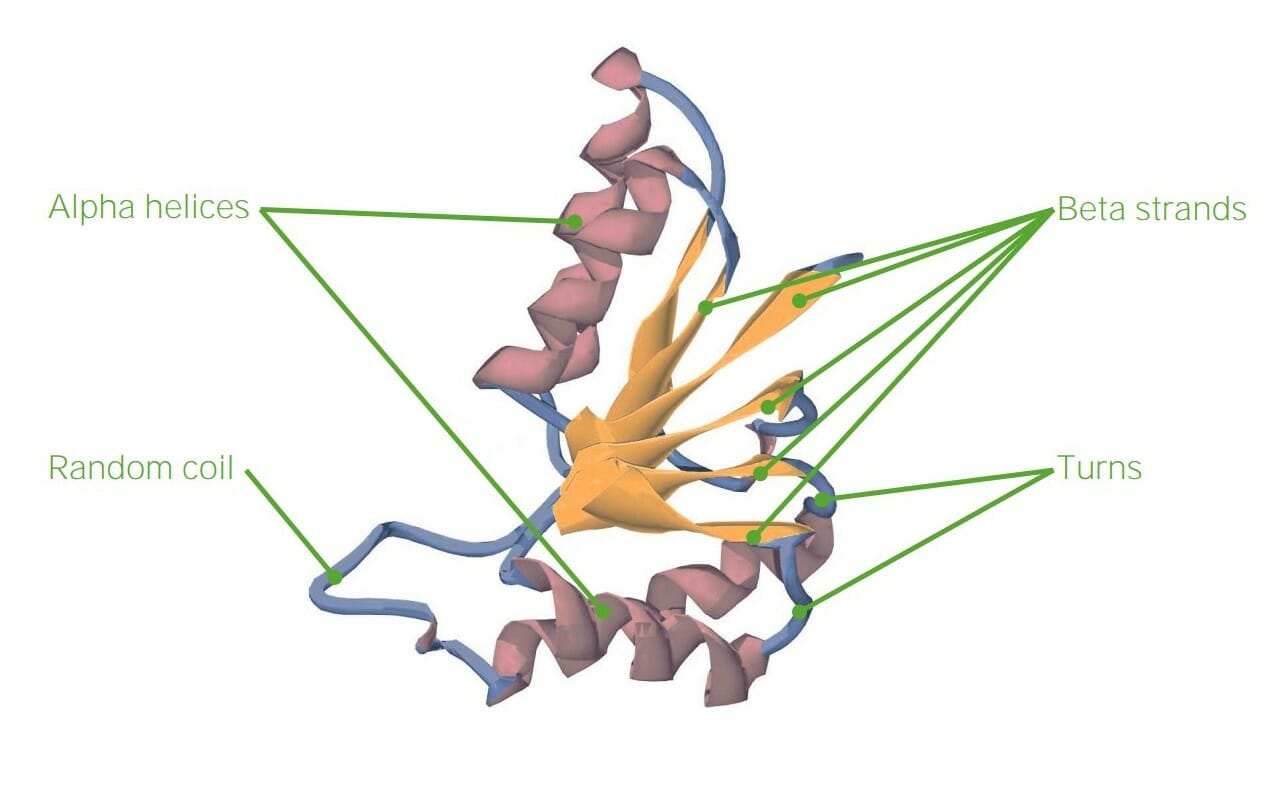Playlist
Show Playlist
Hide Playlist
Quaternary Structure and Summary – Peptides
-
03 Basic Peptides.pdf
-
Reference List Biochemistry.pdf
-
Download Lecture Overview
00:00 protein. 00:02 The next level of protein structure is that of quaternary structure. Quaternary structures are those that arise as a result of interactions between individual polypeptide units. The image you see on the screen is that of hemoglobin, which has four separate polypeptide chains interacting with each other. 00:19 Quaternary structure is relatively easy to understand because it has the same forces helping to stabilize it, that we saw in tertiary structure. These of course include hydrogen bonds that we saw before, disulfide bonds, ionic bonds, hydrophobic bonds and metallic bonds. So the very same forces that stabilize tertiary structure will also stabilize quaternary structure. So the four levels of protein structure that we see are primary, secondary, tertiary and quaternary as depicted on this slide. 00:56 Now there are differences that occur in the structures of proteins as a result of the environment in which the protein finds itself. So consider for example first, myoglobin. Myoglobin is shown in the figure here and myoglobin is an oxygen storing protein related to hemoglobin. 01:14 It only has a single polypeptide chain. When we examine the structure of myoglobin and we compare it to the structure of another protein that is found in membranes, we see some significant differences. First of all, myoglobin is found in the cytoplasm of cells, it's in an aqueous environment. Proteins that are found inside of membranes are in a very different environment. In the middle portion of the membrane, there's no water. In the other portions of the membrane, above and below, there is water. Now what happens as a result of the locations of these things is first of all, for myoglobin, we see that myoglobin has the hydrophobic amino acids located away from water on the inside of the molecule as I described previously. We see a preference for the hydrophilic amino acids to associate on the outside of hemoglobin, where they can interact with water. And this helps to give hemoglobin stability in the environment in which it finds itself. By contrast, the protein that's found in the membrane of cells is in a hydrophobic environment and that hydrophobic environment is conducive to interactions with hydrophobic amino acids. 02:26 So we can see that this protein that's shown within this lipid bilayer as it's called here, has regions that are hydrophobic, located in the middle and actually on the outside of the protein interacting with the nonpolar portions of the lipid bilayer. By contrast, we can see the hydrophilic amino acids are located on the top and bottom portions of this folded protein. The top and the bottoms are the place around the lipid bilayer where the water molecules will actually be found. So what we've seen here then is that the environment in which a protein finds itself can dictate structure. Myoglobin having one structure, the protein embedded in the membrane having a very different kind of a structure. 03:07 Structure is essential for function. That's true whether that structure is an amino acid as we have described, or a folded protein, as we have seen throughout this lecture.
About the Lecture
The lecture Quaternary Structure and Summary – Peptides by Kevin Ahern, PhD is from the course Biochemistry: Basics.
Included Quiz Questions
Which of the following, protein structures, is not stabilized by hydrogen bonds?
- Primary
- Secondary
- Tertiary
- Quaternary
- Binary
In membrane-bound proteins, where are the hydrophobic amino acids preferentially located?
- Lipid bilayer
- Surface of cell
- Amino terminus
- Carboxyl terminus
- In the cytoplasm of the cell
Which of the following is NOT true regarding the quaternary structure of proteins?
- Myoglobin is composed of two alpha and two beta chains of hemoglobin.
- The quaternary structure of a protein consists of an aggregation of two or more polypeptide chains.
- In the quaternary structure, the main interactions between different polypeptide chains are disulfide bonds, ionic bonds, metallic bonds, hydrogen bonds, and hydrophobic interactions,
- In the quaternary structure of a protein, the individual polypeptide units act as a single functional supermolecule.
- The hemoglobin is a heterotetrameric protein composed of two alpha and two beta chains of hemoglobin.
Customer reviews
5,0 of 5 stars
| 5 Stars |
|
1 |
| 4 Stars |
|
0 |
| 3 Stars |
|
0 |
| 2 Stars |
|
0 |
| 1 Star |
|
0 |
thanks for teaching me in such a clear, precise, and yet enriching way





